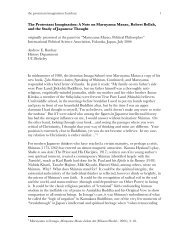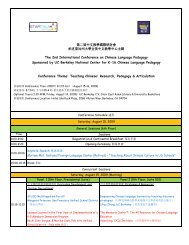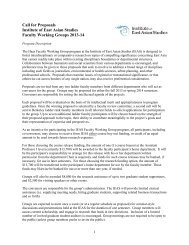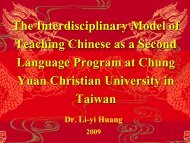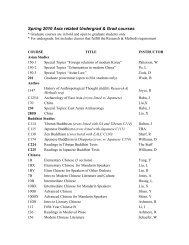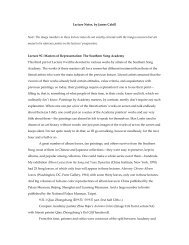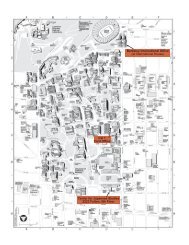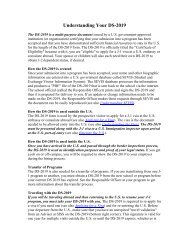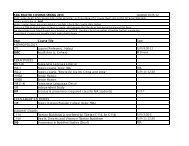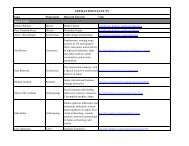Third Edition Spring 2013 - Institute of East Asian Studies, UC ...
Third Edition Spring 2013 - Institute of East Asian Studies, UC ...
Third Edition Spring 2013 - Institute of East Asian Studies, UC ...
Create successful ePaper yourself
Turn your PDF publications into a flip-book with our unique Google optimized e-Paper software.
the Malays and other indigenous peoples <strong>of</strong> Malaysia. 4 Throughthis categorization, Bumiputera has become the dominant majority<strong>of</strong> the country to the exclusion <strong>of</strong> ethnic Chinese and Indians.As <strong>of</strong> 2010, bumiputera accounted for 67.4% <strong>of</strong> the country’s totalpopulation, followed by Chinese at 24.6%, Indian (7.3%) and others(0.7%). 5As I have mentioned previously, the Chinese represent thesecond largest ethnic group in Malaysia with a population <strong>of</strong> nearlyseven million, 6 and their presence is significant by any measure.With a handful <strong>of</strong> active forces representing their communal interests,ethnic Chinese have played indispensible roles in the Malaysianpolitical arena. On the other hand, Malaysian politics is stillpredominantly ethnic-based and largely Malay-dominated.The Barisan Nasional (BN), along with its predecessor, theAlliance—largely comprised <strong>of</strong> ethnic-based political parties suchas the United Malays National Organization (UMNO), the MalaysianChinese Association (MCA) and the Malaysian Indian Congress(MIC)—has been the only ruling party coalition since the country’sindependence. 7 While ostensibly functioning as a multi-ethnic politicalparty coalition, the BN has been predominantly controlledby UMNO. Over the past five decades, the country’s prime ministersand the heads <strong>of</strong> the key ministries have always been members(Malays) <strong>of</strong> UMNO. Despite an <strong>of</strong>ficial consensus <strong>of</strong> pursuingracial harmony, to a large extent, each constituent party <strong>of</strong> the BNprimarily works in accordance with their respective ethnic interestsin hope <strong>of</strong> securing and maximizing votes from their own community.In fact, the origin <strong>of</strong> Malaysia’s communal politics can be4 According to the 2004 CIA World Factbook, Malays account for 50.4% <strong>of</strong> thetotal population, followed by Chinese 23.7%, indigenous 11%, Indian 7.1% and others7.8%. Central Intelligence Agency, The World Factbook, https://www.cia.gov/library/publications/the-world-factbook/geos/my.html (accessed 10/24/2012).5 Department <strong>of</strong> Statistics, Malaysia, Population and Housing Census, Malaysia2010, http://www.statistics.gov.my/portal/index.php?option=com_content&view=article&id=1215&Itemid=89&lang=en,(accessed 10/26/2012)6 ibid.7 The Barisan Nasional (also historically known as National Front) was formedin 1973 as the successor to the Alliance. Besides UMNO, MCA and MIC, participants <strong>of</strong>the BN also include other constituent parties such as Malaysian People’s MovementParty (GERAKAN) and People’s Progressive Party (PPP).traced back much earlier when Malayan/Malaysian people werefighting for independence. Although there was a wide range <strong>of</strong> politicaloptions advocated by different interest groups, the centralissues were always concentrated within the debate between twomajor camps: the bumiputera, who advocated the revival <strong>of</strong> Malaysovereignty as it existed in the pre-colonial era, and the non-Malayimmigrants, who struggled for equal rights and permanent citizenshipwithin the new country. In many Malay extremists’ view,“immigrants formed an inextricable part <strong>of</strong> the colonization process”and thus, the realization <strong>of</strong> the decolonization must be conductedwith an emphasis on the fact that “the land belongs to theMalays.” 8 In contrast, the Chinese and Indians were particularlyanxious to end colonization through popular sovereignty, includingthe participation <strong>of</strong> immigrants by granting them rights equalto the indigenous. As Muhammad Ikmal Said argued, “(The Malay’sspecial position or equal rights) is an open question and is an object<strong>of</strong> struggle. Such a struggle, <strong>of</strong> course, would not occur if theimmigrant communities in question are small, as they could be accommodated,that is, ‘controlled’, easily. On the other hand, if theyform a large proportion <strong>of</strong> the population, an economically strongermajority as in the Malayan case, the implications are very different.”9 In this sense, each ethnic group was big enough to contestthe others, but no single group had the absolute strength necessaryto take the lead without making compromises. This fact also ensuredthat almost all political issues in Malaysia are approached ascommunal struggles, or at least in most circumstances, communalinterests must be taken into account as a primary consideration.As <strong>of</strong> 1961, there were 7.19 million people living in Malaya,3.57 million <strong>of</strong> whom were Malays and were accounted the majority<strong>of</strong> the population; whereas within a Chinese population <strong>of</strong>2.63 million, only 880,000 had citizenship. 10 Despite the economicadvantages the ethnic Chinese enjoyed, they were politically un-8 Kahn, Joel S., and Francis Kok-Wah Loh, 1992, Fragmented vision: culture andpolitics in contemporary Malaysia. Honolulu, HI: University <strong>of</strong> Hawaii Press. P2619 ibid. P276.10 Sabah and Sarawak were not incorporated into Malaysia until 1963. BarisanSocialis Malaysia, “Malaixiya De Yiyi He Qiantu 马 来 西 亚 的 意 义 和 前 途 (The Meaningand Prospect <strong>of</strong> Malaysia: Lim Kcan Siew’s Speech in Johor),” Huo Yan Bao (Nyala), KualaLumpur: She Zhen, Vol. 3, Issue 10, May, 1963.5 Kankan Xie Ethnicity And China-Malaysia Relations 6




